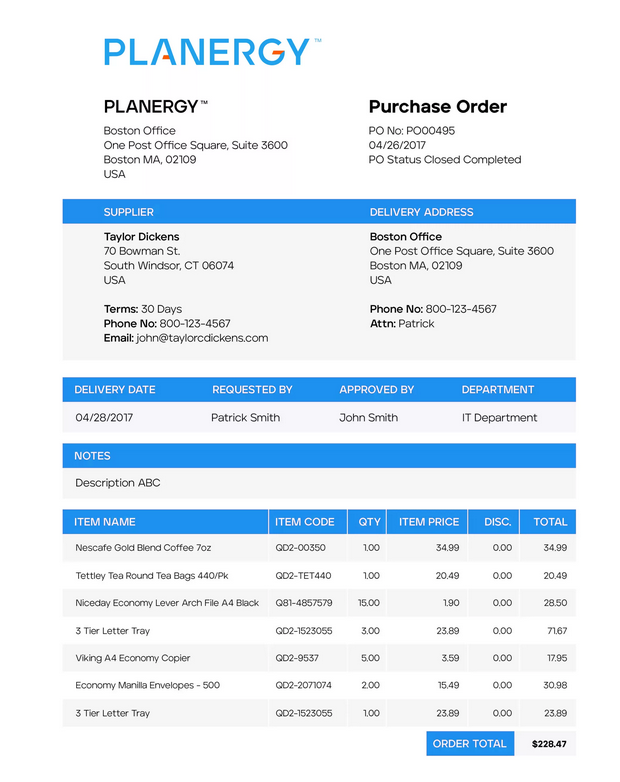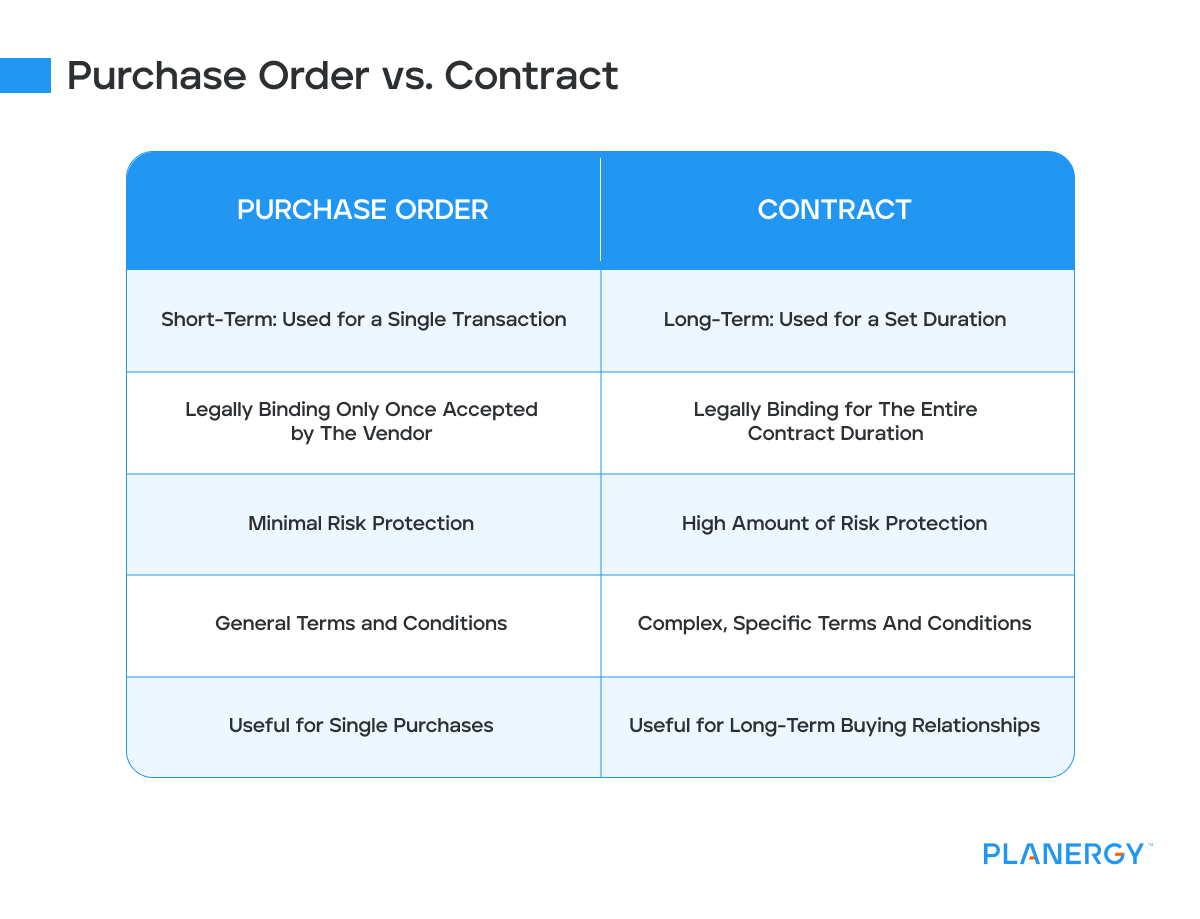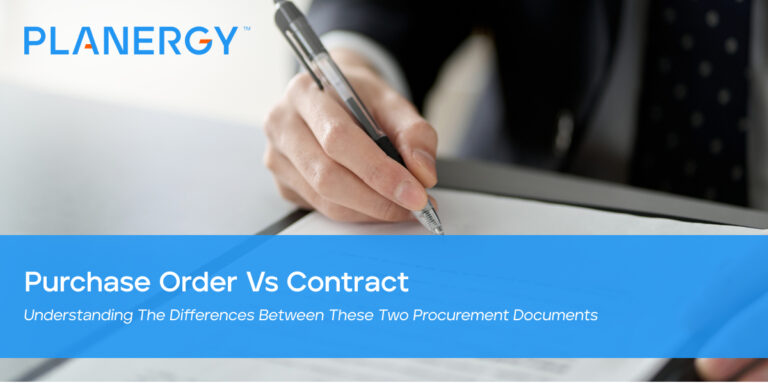While a purchase order is technically a legally binding agreement, there are some key differences between POs and purchasing contracts between buyers and sellers.
For one, a PO is only a ‘contract’ for one order and doesn’t become legally binding until the vendor accepts it. A purchase contract is a more long-term agreement that works alongside POs.
This article will spell out the differences and similarities between POs and contracts, teach you how to use both in tandem, and help you discover the best tools for managing them.
What is a Purchase Order?
A purchase order is a formal document that requests a purchase of goods or services. It’s sent from the buyer to the seller.
The purchase order includes item descriptions, quantities, prices, payment terms, and more. It also includes a purchase order number, the date of issue, and the signature of the person authorizing the purchase.

There are various types of purchase orders. The approval of purchase requests can be managed using purchase order software to ensure careful spend management with approved suppliers.
For example, a blanket purchase order (also known as a blanket purchase agreement or call-off order) is a PO that allows for multiple delivery dates.
Often, blanket POs are used to take advantage of predetermined pricing over a negotiated period of time. These are typically used to make recurring purchases on a regular basis.
What is a Contract?
In the procurement world, a contract details the products or service deliverables being sold, sets the agreed-upon prices, and defines the terms and conditions of the purchase agreement. There are also various types of procurement contract.
The main difference from a PO is that a contract does this for a certain period of time, while a PO is for only one purchase.
Companies most often negotiate purchase contracts for long-term arrangements where they expect to be making many repeat purchases over a given period of time.
Internally, contracts are nice to have because they can reduce the amount of work and approvals needed to make a purchase, as prices and terms have already been set.
A purchase category where contracts are commonplace is services. A contract for services will spell out exactly what services are being delivered, within what time period, and how often the services take place.
The contract can also specify how often the service provider gets paid, which correlates with how often the company will submit POs for the service. This is ideally suited for services procurement.
Contracts are useful for any recurring purchase, whether that be goods or services. Generally, if your company is planning to regularly purchase goods or services, it’s not a bad idea to set up a contract for it.
It’s common for businesses to create contracts with their largest vendors. Then, they use purchase orders to track purchases under the terms of the contract, which helps ensure adherence to it.
Is a PO a Form of Contract?
When the seller formally accepts the PO document, it becomes a legally binding contract. This helps the seller feel comfortable fulfilling the order before payment is received, as most POs have payment terms that don’t require payment for 30 to 90 days.
Blanket purchase orders are also legal documents once accepted by the supplier. However, they do not eliminate the need for a formal contract with the supplier.
How POs and Contracts Interact
When there is a contract in place, PO creation and approval take on a different process.
That’s because the contract has already set the approved prices and terms and no one has to worry about negotiating anything until the next contract renewal period.
With the contract ready, a company can set a purchase release order. This is another word for purchase order, but only applies to POs that are within a contract.
Once the contract has been negotiated, the purchase release order is created based on the pre-determined prices, delivery timelines, and payment terms, which helps to streamline the purchasing process.
What Are the Differences Between a Contract and a Purchase Order?
While purchase contracts are similar to POs, a PO is not the same as a contract. There are some key differences between contracts and POs, which we will detail below.
Purchase Order vs. Contract
| Purchase Order | Contract |
|---|---|
| Short-term: used for a single transaction | Long-term: used for a set duration |
| Legally binding only once accepted by the vendor | Legally binding for the entire contract duration |
| Minimal risk protection | High amount of risk protection |
| General terms and conditions | Complex, specific terms and conditions |
| Useful for single purchases | Useful for long-term buying relationships |

Long Term vs. Short Term
The main difference between contracts and PO is the duration. A purchase order represents a single business transaction. Contracts are used for long-term arrangements between the buyer and seller.
Contracts outline the pricing and terms for all of the vendor’s purchase orders within the contract’s valid timeframe. If you have a contract with a vendor for a year, all purchase orders over the course of the year must comply with the contract terms and conditions.
After that year is over, the contract can be renegotiated and renewed. This helps the purchasing department because they only have to figure out pricing and terms once per year, rather than for every purchase. It also gives them a chance to negotiate favorable renewal options every year.
Legally Binding Protections
While similar, the legality of contracts and POs have one key difference. POs do not become binding documents until the seller accepts them. Contracts, on the other hand, are legal documents from the beginning.
Once both parties sign the contract legally binding protections for both buyer and seller kick in for the agreed-upon time period.
Risk Protections
Contracts are stronger for risk protection than purchase orders alone. Therefore, the riskier the business relationship, the better it is to use a contract. A contract holds more legal value than a purchase order.
Contracts spell out the responsibilities and performance requirements for each party involved, making them better for situations where there is a significant risk to your supply chain or risk of impacting the delivery of your services if the supplier does not meet their requirements.
In a situation where you are depending on a vital good or service to keep your business afloat, having a contract will reduce risk more than just sending POs.
However, it’s a good idea to use contracts alongside POs for risk management. Contracts on their own do not specify quantities or delivery times, which is why individual POs are also needed alongside the contract.
The Complexity of Terms and Conditions
Terms and conditions are typically listed in both contracts and purchase orders. However, terms and conditions are more specific in contracts.
Contract purchasing terms and conditions contain more specific details such as performance standards, the scope of work, and how to deal with change management requests. Contracts are useful when a complex set of terms needs to be made clear.
Purchase order terms and conditions typically don’t contain the same amount of detail because they are only a one-time contract. It’s not worth everyone’s time to figure out all of these details.
For complex terms and conditions that take place for a multitude of purchases, contracts make sense. However, POs still help by providing details for a single purchase.
Different Uses
POs and contracts are both important commercial documents, but they serve different purposes. Because of their different levels of legal protection and specificity, purchase orders alone are useful for single short-term purchases while contracts are better for building long-term buying relationships.
When you need to reduce risk exposure, create a specific service agreement, or set agreed prices for an item you’ll be purchasing regularly, contracts are extremely useful.
The Best Way To Use POs and Contracts Together
It’s clear that for short-term purchases you won’t need to create a contract, but for long-term purchase arrangements you will. Using a procure-to-pay software solution can help you navigate the complexities of both.
Using Planergy, you can upload contracts to each vendor profile. Then, you can set up rules in the purchasing system so that the contract is automatically adhered to when employees submit purchase requisitions for approval.
You can also save time by setting your purchase order policy with a purchase order approval flow that allows orders that fall within the contract terms and conditions to be automatically approved.
The procurement world is complex, but software can make it much easier to navigate. Having all of your contract documents and vendor information in one place helps, and having a system to automate purchases based on those documents helps even more.
Using Planergy for contracts, POs, purchases, and more can set your business up for long-term contract management and purchasing success.




